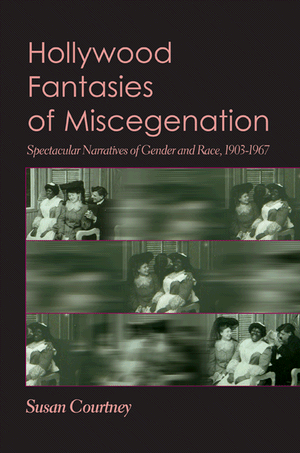“Miscegenation” Making Race in AmericaPosted in Books, History, Media Archive, Monographs, Politics/Public Policy, Slavery, Social Science, United States on 2009-11-02 16:59Z by Steven |
“Miscegenation” Making Race in America
University of Pennsylvania Press
2002
216 pages
6 x 9, 19 illus.
Cloth: ISBN 978-0-8122-3664-4
Paper ISBN: 978-0-8122-2064-3
Elise Lemire, Professor of Literature
Purchase College, State University of New York
In the years between the Revolution and the Civil War, as the question of black political rights was debated more and more vociferously, descriptions and pictorial representations of whites coupling with blacks proliferated in the North. Novelists, short-story writers, poets, journalists, and political cartoonists imagined that political equality would be followed by widespread inter-racial sex and marriage. Legally possible yet socially unthinkable, this “amalgamation” of the races would manifest itself in the perverse union of “whites” with “blacks,” the latter figured as ugly, animal-like, and foul-smelling. In Miscegenation, Elise Lemire reads these literary and visual depictions for what they can tell us about the connection between the racialization of desire and the social construction of race.
Previous studies of the prohibition of interracial sex and marriage in the U.S. have focused on either the slave South or the post-Reconstruction period. Looking instead to the North, and to such texts as the Federalist poetry about Thomas Jefferson and Sally Hemings, James Fenimore Cooper‘s Last of the Mohicans, Edgar Allan Poe‘s “Murders in the Rue Morgue,” and the 1863 pamphlet in which the word “miscegenation” was first used, Lemire examines the steps by which whiteness became a sexual category and same-race desire came to seem a biological imperative.
Table of Contents
- List of Illustrations
- Introduction: The Rhetorical Wedge Between Preference and Prejudice
- 1. Race and the Idea of “Preference” in the New Republic: The Port Folio Poems About Thomas Jefferson and Sally Hemings
- 2. The Rhetoric of Blood and Mixture: Cooper’s “Man Without a Cross”
- 3. The Barrier of Good Taste: Avoiding A Sojourn in the City of Amalgamation in the Wake of Abolitionism
- 4. Combating Abolitionism with the Species Argument: Race and Economic Anxieties in Poe’s Philadelphia
- 5. Making “Miscegenation”: Alcott‘s Paul Frere and the Limits of Brotherhood After Emancipation
- Epilogue: “Miscegenation” Today
- Notes
- Bibliography
- Index
- Acknowledgments





